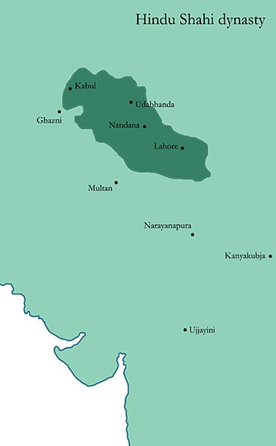Talk:Ānandapāla Śāhī’s Guru-Dakṣiṇā to his Guru Ugrabhūti Bhaṭṭa
By Vishal Agarwal
From the 7th to the early 11th centuries CE, the regions corresponding to present-day northwestern Pakistan and eastern Afghanistan were ruled by the Hindu Śāhi dynasty. Their kingdom, often referred to as the Hindu Śāhi Rājya, had its capitals at Kābul, Puruṣapura (modern Peshawar), and other cities. King Anandapāla Śāhi ruled this dynasty from approximately 1001 to 1010 CE.
Anandapāla’s spiritual preceptor and teacher, Ugrabhūti Bhaṭṭa, was a distinguished scholar of Sanskrit grammar who authored an influential treatise on the subject. The neighbouring Hindu kingdom of Kaśmīra, to the east, was also known for its centres of learning and scholarship. In order to promote his guru’s work, Anandapāla sent copies of the text to the learned scholars of Kaśmīra.
However, the Kaśmīra scholars of that era were reputed to be highly conservative and slow to adopt new works. Disheartened by their indifference, Ugrabhūti Bhaṭṭa contemplated abandoning his scholarly pursuit. His disciple, Anandapāla, intervened with an act of remarkable generosity. He announced that any scholar of Kaśmīra who studied and appreciated his guru’s treatise would receive 200,000 gold coins and other royal gifts.
Tempted by the reward, the Kaśmīra scholars began to study the text, and soon Ugrabhūti’s grammar achieved great recognition across the region. Anandapāla’s act of reverence toward his teacher thus ensured that the work gained lasting influence.
Within two decades, however, Anandapāla’s own kingdom fell to Maḥmūd of Ghaznī, the ruler of the Ghaznavid Empire. Maḥmūd’s invasions brought extensive destruction to the northwestern Hindu realms. Temples were demolished, brāhmaṇas were killed, śāstras were burned, and many Hindus were forcibly converted to Islam. Hindu dharm and learning were almost completely extinguished in Afghanistan and the adjoining territories of Pakistan.
Yet, it took several more centuries for Muslim rule to extend over Kaśmīra. Despite later invasions, Sanskrit learning survived there for many generations. The grammatical treatise of Ugrabhūti Bhaṭṭa endured in these regions as a testament to the devotion and foresight of King Anandapāla Śāhi. Remarkably, his guru’s work continued to be used as a textbook of Sanskrit grammar in certain parts of northern India until the early 20th century CE.

